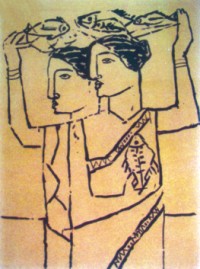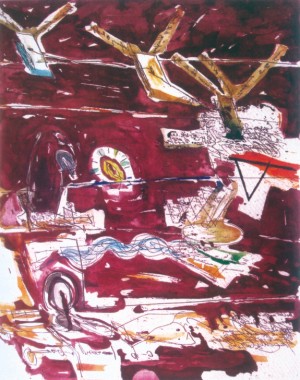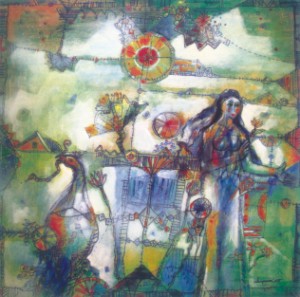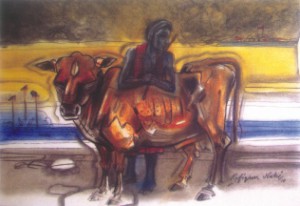|
Art
When Basilio Beckons
A number of art galleries have mushroomed in the capital over the past two decades. Speaking of whether one needs a new gallery in the metropolis – with numerous art outlets already existing in the city– Maksudul Ahsan, the curator-cum-artist says, “DOHS, Mohakhali where Basilio is located, brings in buyers from Uttara, Gulshan, Banani, as well as those from Dhanmondi and Kalabagan. It covers areas like Indira Road, Baily Road, Shegunbagicha and even Old Dhaka. Thus Basilio is centrally placed.” Speaking about the size of the gallery, Ahsan says that, it is not the number of rooms or the area covered that matters: This is an outlet for buyers to examine the paintings and to encourage up and coming, promising painters as well.
 |
Kazi Abdul Baset
Photo: courtesy |
“Basilio” which opened on the weekend, 14th January, had, for the first bash, 14 eminent artists, like Qayyum Chowdhury and Rafiqun Nabi, who should be patrons of visual art, on their own, says the connoisseur cum curator Ahsan. Hence, “Basilio” is not aimed at the upper echelons of Dhaka society, or just the expatriates and its haut bourgeois. Most galleries are like art shops, he says. “A gallery has responsibilities towards art and artists. Sure, artists give a painting; galleries take a commission, and help sell the visual art sample. This alone is not enough. The gallery should provide the backing of a painter – and help to face the vicissitudes of life. A gallery– as is seen in neighbouring India – has a choice collection of artists that it picks up and grooms. The artists never feels that he is facing the world alone,” says Ahsan. He should be able to make a living, as well have funds to get more canvas, paints and brushes. Hence, the gallery is like some office, which also helps larger galleries, which might be organising a large, nation-wide exhibition, he adds.
Basilio's first exhibition includes the first generation artists like Qayyum Chowdhry, late Abdul Basset, Sarit Roy Chowdhury, Rafiqun Nabi, Monirul Islam, Mahmudul Haque, Hamiduzzaman Khan, Abdus Shakur Shah, Chadra Shekhar Dey, Biren Shome, Abul Barq Alvi, Shahid Kabir and Alokesh Ghosh. The art comprise of oil paintings, watercolour, pen and pencil sketches, prints, acrylic, apart from mixed media. Later on, the gallery will have different collections of art works, aiming at least 50 different painters and sculptors.
Ahsan has spent about eight years in New Delhi– where his wife was studying music under an Indian government scholarship. Now in his mature years, he wants to do something on his own, as his contribution to society. He has been dealing with artists from Epar-Opar Bangla for a fairly long time at “Shilpangan”, by arranging exhibitions of paintings from both Bangladesh and West Bengal and even the rest of the Indian subcontinent having rubbed shoulders with the foremost artists of India, like MF Mirza and Souza.
 |
Monirul Islam, Photo: courtesy |
In his studio at Dhanmandi, one can see a fairly large collection of Indian masters. Sitting in the midst of this unique collection, over tea and “chanachur” Ahsan once again stresses the fact that art lovers and connoisseurs are spread over the entire city. Asked if it is important to have a good patron in the form of a gallery, Ahsan stresses that an artist not only has to earn the “bread and butter”, but also need enough to buy the necessary equipments to carry the his work, in future. Many artists, says Ahsan, have gone into commercial art in a big way; giving up painting and sculpture– and have even resorted to drugs; alcohol and even suicide, when things have become difficult, both economically and socially, as was the case of European masters in the past, eg Vincent Van Gogh. Ahsan says, “An artist needs to struggle from the outset. It is blood, sweat and tears for anyone not born with a silver spoon in his mouth. Even to give invitations, the artist needs to go to each and every party to communicate with prospective buyers; to wine and dine with prospective patrons requires time, energy and money. Many promising artists have moved on to other fields such as pure business of selling painted cushions and clothes overseas, or even sugar and condensed milk or even dealing with the stock market. The creativity within them is not necessarily valued, where everyone is rushing to get ahead. The courage and occasion to respond to one's conscience and desire for true creation has not always been there for the artist. I myself have struggled, clenching my teeth, determined that I'll hold on to art, what may. This is although I come form a landed gentry family in Chandpur, with aunts and uncles to back me up, if I wanted them to. But I wanted to, make it alone, although this wouldn't have been possible without the backing of my wife, Shumi (Fahima Samad, who studied classical and vocal music at New Delhi, going there with an Indian Council for Cultural Relations (ICCR) scholarship) who teaches singing notations at a nearby music centre. She lends a hand with all my ventures in the art world, as does also my teenaged daughter Rhydi. Even to accept an artist as a life partner requires a great deal of patience and understanding.”
 |
Samarjit Roy Chowdhury, Photo: courtesy |
Even today Ahsan is attached to numerous galleries in New Delhi like “Art Today”, and of shoot of “India Today”; “Dhumimal Art Gallery;” “Konika Art Gallery;” and “Art Forum”. He is also attached to numerous leading art galleries in Kolkata. In New Delhi alone Ahsan has stayed for eight years. Talking about the attitude of art lovers, across the border, Ahsan says that here in Bangladesh, he himself has not ever had government support, as such. Whatever he has done is by his gumption and spirit.
“I believe I'm self-oriented and self-dependant. I haven't craved for overseas scholarships to widen my horizon. Art is such a difficult subject that one cannot survive without help. It is like a plant that requires regular watering and care. The industrialists in India for instance, are often patrons of art. The government is there to lend support also. One knows that in Europe and the Far East, this is also the case. In our country our mainstream art, classical music, is not supported adequately. A band music performance, however, will get the support of banks and insurance companies, without difficulty. For a welcome change in society, I don't think this is a good attitude,” says Ahsan.
 |
Rafiqun Nabi, Photo: courtesy |
“I believe that to promote our culture, one mustn't ignore the treasure trove of our past. If the changes are brought about correctly, this might be good for our society. Instead of supporting mainstream art, questionable art with easy appeal is encouraged. Abroad, as far as I understand, there are supporters of art like band music, but art with rich heritage is the primary concern of most patrons. Large organisations, abroad, are ever ready, to promote their own culture.”
Touching the present art environment in Dhaka, in general, where the moneyed class is openly wowed, Ahsan says that the recent attitude towards buying paintings have changed somewhat. We find more than foreign delegates being patrons of paintings. The local art enthusiast, he says, often buys the paintings and sculpture, even though the payment may be in instalments. Investing on art works today is the passion of a number of art buffs, among the younger generation. Even without going to functions, to rope in buyers, one can survive, as he does himself, says Ahsan. Just selling to friends and acquaintances, has given him the necessary financial support.
Speaking about the development of visual art in Bangladesh, as compared to that in other parallel countries in the subcontinent, Ahsan concludes his parlay by saying that in the visual art world the artists have made a fair progress, as we've had a linkage with modern art in the first generation. “This includes Aminul Islam, Rafiqun Nabi, Abdur Rezzak, Hamidur Rahman, Navera Ahmedwho have all studied in Europe. We've had an international attitude since then,” he says.
“This worked like a revolution. Some of the artists have maintained our cultural roots, whilst others haven't. Ultimately, these artists have gone to their original place, keeping traditions in mind. Murtuja Baseer, for example did absolutely modern work. After his education in Europe, he did the Wall series where one saw abstract expressionism, which Mohmmed Kibria also follows even today. Expressionism was recognised, in the west, even way back. One cannot judge country-wise. It is a global matter, China for example, has strongly held on to its traditions. In Bangladesh, we can't compare with India, which looks back to Ajanta and Elora. We don't quite have that beginning since the time of Zainul Abedin's Art College. However, folk art has influenced us, as in the case of forms and colours used by Zainul Abedin, Quamrul Hassan and more recently, in the case of Abdur Shakoor Shah etc,” continues Ahsan.
Copyright
(R) thedailystar.net 2010 |
| |
